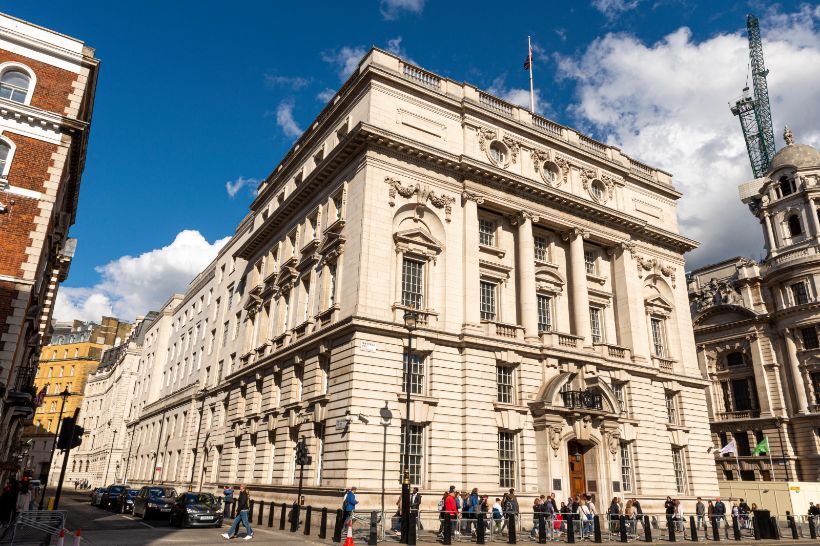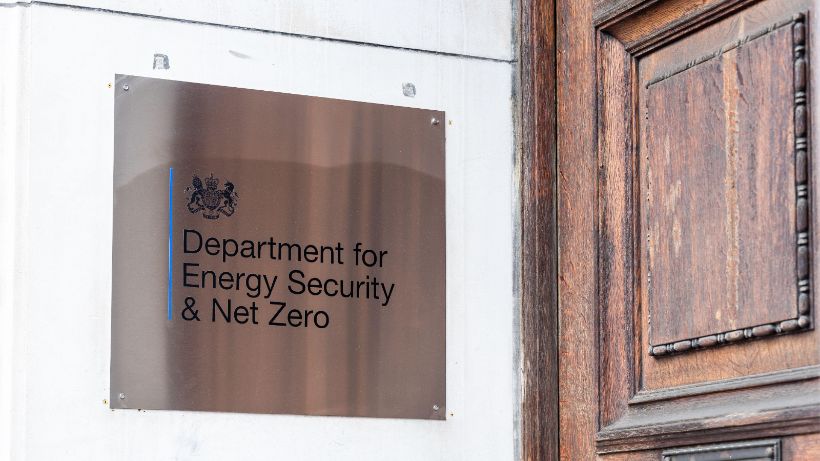As workers across many sectors have adjusted to a hybrid, hot-desking work pattern, scrabbling for the best desks – or indeed any desk – has become a regular ritual in many organisations, particularly on peak days such as Tuesdays.
In the civil service, a steady rise in headcount since 2016, the shrinking of the government estate since 2010 and rigid mandates on office attendance can make the scrabble particularly intense.
Data published last month in response to a series of parliamentary questions shows that of 180 offices across 19 departments and agencies, less than a third have enough desks for all their staff to come in at once.
Civil servants at the Department for Energy Security and Net Zero’s London HQ, 55 Whitehall and 3-8 Whitehall Place, can lay claim to being among the worst affected. The building, according to DESNZ’s response to a PQ from Conservative MP Sir Ashley Fox, has 571 desks for 2,969 officials, which is one desk per five officials. This is the worst ratio of desks-to-officials across all the offices for which departments have provided data.
The building – which sits on a corner of Whitehall and Whitehall Place – is also the only departmental HQ to have reached 100% capacity according to the weekly occupancy data published between January 2023 and May 2024.
A survey carried out by PCS last year found that three-quarters of respondents based at the building were concerned about not being able to find a desk. Respondents to the survey said this was impacting productivity, since they were unable to sit close to their team and struggled to find quiet and private spaces for work.
DESNZ has been working with the Government Property Agency to address some of these concerns, but before exploring the changes they’ve made, it’s worth asking what exactly we mean by a desk.
CSW discovered its definition of what counts as a desk space (for answering the PQ) meant the work station must be both “IT-enabled” and be height-adjustable. DESNZ told CSW it has 1,149 “work settings” and "places to work", 920 of which are IT-enabled, and 571 of which are height-adjustable. When including meeting rooms, this rises to 1,651.
But not all departments use the same definition. HMRC, for example, gave figures for “workspaces” in its PQ answer, saying: “Our offices have different types of workspaces which allow people to match the task to the most suitable space. We therefore use workspaces rather than the number of desks.” The MoD, which only gave figures for its Main Building, used the term “workplaces”. The Department for Education, meanwhile, gave the descriptor “capacity (desk only)”.
If DESNZ were to include all work spaces other than meeting rooms, the ratio would improve to around one desk per 2.5 officials, similar to, for example, the Department for Business and Trade and the Department of Health and Social Care’s HQs. If it were to include meeting rooms, this would rise to a ratio of around one desk per two officials.
To give another example, DSIT said its HQ at 22-26 Whitehall Place – which it shares with some DESNZ staff who aren’t based at the DESNZ HQ – has 204 desks for 924 officials.
This represents roughly one desk per five officials. But, according to DESNZ, the office contains 439 desks which are shared between the two departments. Using this total of all desks and staff in the building, we would get a much more average-looking ratio of around one desk per 2.5 people.
How are the capacity issues affecting officials at DESNZ’s HQ?
 DESNZ HQ, 55 Whitehall and 3-8 Whitehall Place
DESNZ HQ, 55 Whitehall and 3-8 Whitehall Place
While the data published in response to Fox’s PQ may not allow for straightforward comparisons between departments, it does – combined with the survey data from staff working at DESNZ’s HQ – suggest a picture of offices which aren’t always adequate for the current hybrid approach.
Staff told the survey, which was carried out in October last year – three months after they had moved into the office from their previous HQ in Victoria Street – that the lack of desks and inability to book desks “does not allow for flexible working times”.
“You must arrive before 9am to guarantee a desk,” one respondent said. “No desk bookings also negates team days and rotas, as you will not be able to sit next to your team. This, combined with the lack of meeting rooms and quiet spaces removes all benefits of coming to work in the office and reduces productivity.”
Another official highlighted the dearth of private spaces, saying the lack of meeting rooms “means that it's very difficult to have private, confidential conversations in person in the office”.
Staff also expressed concern about the lack of a subsidised canteen.
What has DESNZ done to address the concerns?
A DESNZ spokesperson told CSW that the department, working in collaboration with the Government Property Agency, has made “substantial changes” to improve the workplace.
“Working in close collaboration with our staff networks, this has included more desk space, improved meeting room capacity and additional café access,” they said.
The department said it would “continue to monitor the office space to help employees work productively and comfortably”.

Since the survey, DESNZ and the GPA have added more than 120 extra IT-enabled work settings and increased the capacity of some meeting rooms. They have also made all two-person pods across the building bookable to provide more opportunities for colleagues to reserve spaces for private conversations.
In response to noise concerns, they have undertaken acoustic surveys and installed muffling panels in the noisiest areas of the building.
And to tackle frustration about the lack of a canteen, officials at DESNZ’s HQ have been given access to the café across the road in 22 Whitehall Place, a building the department shares with DSIT.
Have the changes made a difference?
CSW asked a DESNZ official about the current situation, one year on from the survey. They said the increase in desks has made a “slight improvement” but there are “still not enough” proper workspaces, meaning civil servants can struggle to find desks and end up sitting in “unsuitable” kitchen areas.
Due to the capacity issues, only members of the SCS and new recruits are asked to come in for 60% of the week, with an overall 40% target being set.
“At times 40% is fine but there have been many occasions when people cannot find a desk to work from,” the DESNZ insider told CSW.
Staff also still cannot book a specific desk, which makes it difficult for teams to sit together, while booths are often full and meeting rooms are normally booked weeks in advance, they said.
The office situation “doesn’t encourage people to come in”, they said.
Asked about the situation, PCS general secretary Fran Heathcote told CSW: “What’s happening at DESNZ lays bare the absurd nature of the government’s arbitrary instruction for civil servants to return to the office.
“The offices are too small, there are not enough desks and not enough meeting rooms – the existing ones are booked weeks in advance.
“Working in cramped, noisy, chaotic conditions does nothing to help our members work productively.
Heathcote said the government should “engage its workforce – and listen to workers coming forward with plans to boost productivity, improve employee wellbeing and staff retention”.
What does the overall picture look like across the government’s estate?
Leaving aside discrepancies over what counts as a desk, of the 180 offices for which departments have provided statistics in response to Fox’s parliamentary questions:
- 47 have enough space for all of their staff to come into the office on the same day
- 100 can manage 60% at a time
- 133 can cope with half being in at the same time
- 163 have space for 40% on a given day
- And 175 have enough desks for a third to be in at a time
Ratio wise, this means that there are 37 offices where each desk is shared between two or more officials, and five offices which have three or more officials per desk.
Along with DESNZ’s HQ, some of the other offices which have many more officials than available desks include DBT’s Belfast office, which is home to 63 officials but has only 13 desks, a ratio of one desk per four civil servants, and DESNZ’s Cardiff office, which has 56 desks for 223 officials and about the same ratio. And the Treasury has estimated it has a “proportional equivalent” of 85 “workspaces” at Darlington’s Feethams House for 312 civil servants, which also works out at about one desk per four officials.
Of the 52 offices which have at least one desk per staff member, some are significantly under-occupied. DESNZ’s Bristol office, for example, has 35 desks for six officials, and DCMS said it has a sole official working at the government’s hub in Sheffield but four desks available to the department.
These figures do not include the Home Office and Cabinet Office, which both said they could not disclose the number of desks at individual buildings. The Home Office gave total figures – a headcount of 38,775 and 24,311 desks across its core estate – while the Cabinet Office did not give any information on how many desks it has. The Ministry of Justice and HM Courts and Tribunals Service are also not included, with both saying providing the data would have come at “disproportionate cost”. And the Crown Prosecution Service is not included, as it only gave estate-wide figures. The Department for Work and Pensions and MoD are included but only provided figures for their HQs. The Ministry of Housing, Communities and Local Government is the only department which had not responded to the MP’s PQ at the time of publication, with its answer now more than a month overdue.
The figures given by departments are for their most recent headcounts and office capacities and so the desks-per-official in each office will fluctuate as staff join, depart and change offices and as estate changes are made.
If you have information you would like to share on hybrid working arrangements in your department, you can do so in confidence by emailing tevye.markson@civilserviceworld.com